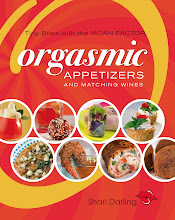
If you're looking to give your family favourite recipes the MOAN factor by adding depth and roundness of flavour, consider adding fortified wine during the cooking preparation.
Unlike table wines, fortified versions are higher in the fifth taste sensation called umami or savoury. The four primary sensations are bitterness, sweetness, sourness and saltiness, experienced on the palate. Umami is the 5th. It is highly regarded in Asian countries and found in many of their fermented, aged, dried and slow roasted foods, such as soy sauce, oyster sauce, rice vinegar, and dried shrimp. In North America we cherish and crave umami in the form of brand name products like Ketchup! We love our slow cooked tomatoes on eggs, french fries and steak! Fresh tomatoes possess simplistic umami. When you slow roast them the umami increases. They become high in synergistic umami.
By adding a splash of fortified wine to a dish you increase its umami content, thus adding depth and roundness of flavour.
A fortified wine is one that has had the addition of an alcoholic spirit, such as grape brandy, or has been infused with herbs, roots, peels or spices. Spirit was originally added to wine to protect it from spoilage during long sea voyages.
Because alcohol is a preservative, a fortified wine, once opened, will store longer than table wine in the refrigerator, up to a few months. So you can use it often in your cooking. Be bold. The alcohol burns away, thus leaving the spirit's flavour presence. Well known types for cooking include sherry, Port, vermouth, Marsala.
This style of wine can be used in the preparation of salads, soups, hors d’oeuvres, entrees and desserts. As a marinade, its high alcohol and acidity tenderizes flesh. Poaching, de-galzing and flavouring are its best uses. Be sure to burn off the alcohol before adding it to cream sauces to prevent curdling.
Desserts incorporating fortified wine don’t freeze well. The other liquids in the dessert freeze more quickly than its alcohol, altering its composition and texture.
Sherry is the most versatile, adding nutty qualities to dishes. It is produced in three styles – dry, medium cream and full cream. Dry sherry is used to flavour soups, as well as served as an accompanying dinner companion. This fortified wine is also added to Asian style dishes and can replace rice vinegar in recipes. If a recipe calls for dry sherry, don’t substitute a sweet one, as this will alter the flavour of the dish.
Port is also a popular cooking ingredient and adds fruity character to a dish. Produced only in Portugal, this fortified wine comes in a few styles, as well. Tawny Port is amber in colour. So, refrain from using this one in a white sauce, as it will turn gray. Ruby Port has a brighter and fruitier flavour. All Ports are a delicious addition to meat dishes and desserts.

Vermouth is infused with herbs and spices, thus adding these same flavours to a dish. It can be red and sweet and is added to red sauce reductions. White versions are produced extra dry to sweet. Dry vermouth can replace white wine is recipes, thus adding more umami to the dish. Sweet vermouth can add delciious flavour to fruit-based desserts.
Marsala is the name of the fortified wine, as well as the name of the Italian city in which it is produced. It is used in the preparation of
 many Italian dishes and possesses an intense amber colour and complex aromas. The aromas come through in the resulting dish, adding dimension. Chicken Marsala is famous and incorporates onions, shallots, mushrooms and herbs.
many Italian dishes and possesses an intense amber colour and complex aromas. The aromas come through in the resulting dish, adding dimension. Chicken Marsala is famous and incorporates onions, shallots, mushrooms and herbs. 




No comments:
Post a Comment